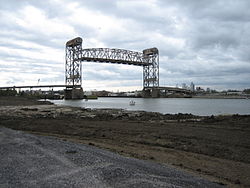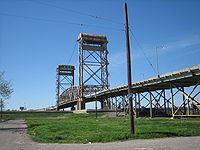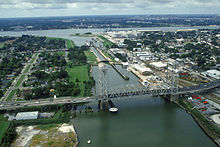- Claiborne Avenue Bridge
-
Claiborne Avenue Bridge 
Claiborne Avenue Bridge in raised positionOfficial name Judge William Seeber Bridge Carries  Louisiana Highway 39, Claiborne Avenue
Louisiana Highway 39, Claiborne AvenueCrosses Industrial Canal Locale New Orleans, Louisiana Design vertical lift bridge Opened 1957 Coordinates 29°58′09″N 90°01′33″W / 29.969096°N 90.025734°WCoordinates: 29°58′09″N 90°01′33″W / 29.969096°N 90.025734°W The Claiborne Avenue Bridge, officially known as the Judge William Seeber Bridge, is a vertical lift bridge in New Orleans, Louisiana over the Industrial Canal. It was built by the Louisiana Department of Highways (later renamed the Department of Transportation and Development) and opened to vehicular traffic in 1957. The bridge has suffered numerous disasters: A barge hit the bridge in 1993, Hurricane Katrina damaged it in 2005, and a car plunged into the canal in 2008 due to a malfunction. The bridge is currently in poor condition.[citation needed]
Contents
Description
The bridge carries four vehicular lanes, two in each direction, of North Claiborne Avenue, which here is also Louisiana Highway 39. It accommodates most marine traffic in the down position. The bridge is located in the 9th Ward of New Orleans, with the Upper 9th Ward on the western side and the Lower 9th Ward on the eastern or "lower" (down river) side. Along with St. Claude Avenue, it is one of the main links of New Orleans with the communities in St. Bernard Parish, Louisiana such as Arabi and Chalmette. Many locals who regularly use the bridge are unaware of the bridge's official name.
Tugboat collision
On May 28, 1993 the tugboat Chris was pushing an empty barge through the canal toward the Mississippi River locks. As was common at the time, the tugboat captain would have to wait to enter the locks, and he was directed to the side of the canal to ground his barge to keep the waterway clear. However, at 3:30 p. m., the barge collided with a support pier of the bridge, causing a 145-foot (44 m) section of the bridge to collapse onto the western canal bank and onto the barge.[1] Two automobiles plummeted off of the bridge, killing one person and severely injuring two others. The waterway was closed to navigation for 2 days, and the bridge was closed for 2 months while the collapsed span was rebuilt. The concrete debris from the collapsed span was used to protect the new support pier from future collisions.
Hurricane Katrina
In 2005 Hurricane Katrina severely affected the areas on both sides of the bridge (see Effect of Hurricane Katrina on New Orleans), with the most extreme devastation on the Lower 9th Ward side. The bridge was out of service for months, left in the up position to accommodate Canal shipping, until it was restored to service in early 2006. Even with the bridge fully functioning, it remains in a state of disrepair. Rust covers the metal part of the bridge. Many community members[who?] wonder why the government has left the bridge in such a dilapidated state, but the issue has not been touched upon by officials yet.[citation needed]
Crossing gates malfunction
On May 20, 2008 17 year veteran New Orleans Police Officer Tommie Felix was killed when his vehicle drove off the bridge and plunged into the canal while the bridge was in the raised position. Eye witness accounts say that the gates which come down to indicate the bridges closure were not functioning at the time, and several other cars came close to driving off the bridge but stopped short. Currently the cause is under investigation.
Crossings of the Gulf Intracoastal Waterway / Industrial Canal / Mississippi River Gulf Outlet West
St. Claude Avenue Bridge

Claiborne Avenue Bridge

East
Florida Avenue BridgeCategories:- Bridges in New Orleans, Louisiana
- Vertical lift bridges
- Bridges completed in 1957
- Bridge disasters in the United States
- Bridge disasters caused by collision
- Bridge disasters caused by maintenance error
- Bridge disasters caused by tropical cyclones
- Road bridges in Louisiana
Wikimedia Foundation. 2010.


